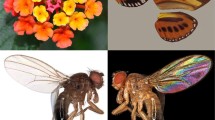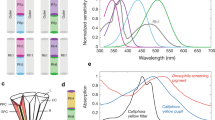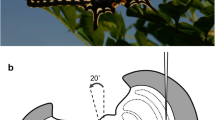Abstract
The fruit fly Drosophila melanogaster can process chromatic information for true color vision and spectral preference. Spectral information is initially detected by a few distinct photoreceptor channels with different spectral sensitivities and is processed through the visual circuit. The neuroanatomical bases of the circuit are emerging. However, only little information is available in chromatic response properties of higher visual neurons from this important model organism. We used in vivo whole-cell patch-clamp recordings in response to monochromatic light stimuli ranging from 300 to 650 nm with 25-nm steps. We characterized the chromatic response of 33 higher visual neurons, including their general response type and their wavelength tuning. Color-opponent-type responses that had been typically observed in primates and bees were not identified. Instead, the majority of neurons showed excitatory responses to broadband wavelengths. The UV (300–375 nm) and middle wavelength (425–575 nm) ranges could be separated at the population level owing to neurons that preferentially responded to a specific wavelength range. Our results provide a first mapping of chromatic information processing in higher visual neurons of D. melanogaster that is a suitable model for exploring how color-opponent neural mechanisms are implemented in the visual circuits.








Similar content being viewed by others
References
Arikawa K, Stavenga DG (2014) Insect photopigments: photoreceptor spectral sensitivities and visual adaptations. In: Hunt DM, Hankins MW, Collin SP, Marshall NJ (eds) Evolution of visual and non-visual pigments. Springer, Boston, pp 137–162
Arikawa K, Mizuno S, Kinoshita M, Stavenga DG (2003) Coexpression of two visual pigments in a photoreceptor causes an abnormally broad spectral sensitivity in the eye of the butterfly Papilio xuthus. J Neurosci 23:4527–4532
Backhaus W (1991) Color opponent coding in the visual system of the honeybee. Vis Res 31:1381–1397
Behnia R, Desplan C (2015) Visual circuits in flies: beginning to see the whole picture. Curr Opin Neurobiol 34:125–132. https://doi.org/10.1016/j.conb.2015.03.010
Behnia R, Clark DA, Carter AG, Clandinin TR, Desplan C (2014) Processing properties of ON and OFF pathways for Drosophila motion detection. Nature 512:427–430. https://doi.org/10.1038/nature13427
Conway BR, Chatterjee S, Field GD, Horwitz GD, Johnson EN, Koida K, Mancuso K (2010) Advances in color science: from retina to behavior. J Neurosci 30:14955–14963. https://doi.org/10.1523/JNEUROSCI.4348-10.2010
Dacey DM, Packer OS (2003) Colour coding in the primate retina: diverse cell types and cone-specific circuitry. Curr Opin Neurobiol 13:421–427
Douglass JK, Strausfeld NJ (1995) Visual motion detection circuits in flies: peripheral motion computation by identified small-field retinotopic neurons. J Neurosci 15:5596–5611
Douglass JK, Strausfeld NJ (1996) Visual motion-detection circuits in flies: parallel direction- and non-direction-sensitive pathways between the medulla and lobula plate. J Neurosci 16:4551–4562
Erber J, Menzel R (1977) Visual interneurons in the median protocerebrum of the bee. J Comp Physiol A 121:65–77
Fischbach K (1979) Simultaneous and successive colour contrast expressed in “slow” phototactic behaviour of walking Drosophila melanogaster. J Comp Physiol A 130:161–171
Fischbach K-F, Dittrich A (1989) The optic lobe of Drosophila melanogaster. I. A Golgi analysis of wild-type structure. Cell Tissue Res 258:441–475
Gao S et al (2008) The neural substrate of spectral preference in Drosophila. Neuron 60:328–342. https://doi.org/10.1016/j.neuron.2008.08.010
Gegenfurtner KR, Kiper DC (2003) Color vision. Annu Rev Neurosci 26:181–206. https://doi.org/10.1146/annurev.neuro.26.041002.131116
Heath SL, Christenson MP, Oriol E, Saavedra-Weisenhaus M, Kohn JR, Behnia R (2019) Circuit mechanisms underlying chromatic encoding in Drosophila photoreceptors. bioRxiv:790295 https://doi.org/10.1101/790295
Hempel de Ibarra N, Vorobyev M, Menzel R (2014) Mechanisms, functions and ecology of colour vision in the honeybee. J Comp Physiol A 200:411–433. https://doi.org/10.1007/s00359-014-0915-1
Hertel H (1980) Chromatic properties of identified interneurons in the optic lobes of the bee. J Comp Physiol A 137:215–231
Hertel H, Maronde U (1987) The physiology and morphology of centrally projecting visual interneurones in the honeybee brain. J Exp Biol 133:301–315
Hu KG, Stark WS (1977) Specific receptor input into spectral preference in Drosophila. J Comp Physiol A 121:241–252
Jacob K, Willmund R, Folkers E, Fischbach K, Spatz HC (1977) T-maze phototaxis of Drosophila melanogaster and several mutants in the visual systems. J Comp Physiol A 116:209–225
Jagadish S, Barnea G, Clandinin TR, Axel R (2014) Identifying functional connections of the inner photoreceptors in Drosophila using Tango-Trace. Neuron 83:630–644. https://doi.org/10.1016/j.neuron.2014.06.025
Joesch M, Schnell B, Raghu SV, Reiff DF, Borst A (2010) ON and OFF pathways in Drosophila motion vision. Nature 468:300–304. https://doi.org/10.1038/nature09545
Kelber A (2016) Colour in the eye of the beholder: receptor sensitivities and neural circuits underlying colour opponency and colour perception. Curr Opin Neurobiol 41:106–112. https://doi.org/10.1016/j.conb.2016.09.007
Kelber A, Vorobyev M, Osorio D (2003) Animal colour vision-behavioural tests and physiological concepts. Biol Rev 78:81–118. https://doi.org/10.1017/s1464793102005985
Kien J, Menzel R (1977a) Chromatic properties of interneurons in the optic lobes of the bee. I. Broad band neurons. J Comp Physiol A 113:17–34
Kien J, Menzel R (1977b) Chromatic properties of interneurons in the optic lobes of the bee. II. Narrow band and colonr opponent neurons. J Comp Physiol A 113:35–53
Kinoshita M, Arikawa K (2000) Colour constancy in the swallowtail butterfly Papilio xuthus. J Exp Biol 203:3521–3530
Kinoshita M, Arikawa K (2014) Color and polarization vision in foraging Papilio. J Comp Physiol A 200:513–526. https://doi.org/10.1007/s00359-014-0903-5
Kinoshita M, Takahashi Y, Arikawa K (2008) Simultaneous color contrast in the foraging swallowtail butterfly, Papilio xuthus. J Exp Biol 211:3504–3511. https://doi.org/10.1242/jeb.017848
Krauskopf J, Williams DR, Heeley DW (1982) Cardinal directions of color space. Vis Res 22:1123–1131. https://doi.org/10.1016/0042-6989(82)90077-3
Lin TY, Luo J, Shinomiya K, Ting CY, Lu Z, Meinertzhagen IA, Lee CH (2016) Mapping chromatic pathways in the Drosophila visual system. J Comp Neurol 524:213–227. https://doi.org/10.1002/cne.23857
Mazzoni EO et al (2008) Iroquois complex genes induce co-expression of rhodopsins in Drosophila. PLoS Biol 6:e97. https://doi.org/10.1371/journal.pbio.0060097
Melnattur KV, Pursley R, Lin TY, Ting CY, Smith PD, Pohida T, Lee CH (2014) Multiple redundant medulla projection neurons mediate color vision in Drosophila. J Neurogenet 28:374–388. https://doi.org/10.3109/01677063.2014.891590
Menzel R, Backhaus W (1989) Color vision honey bees: phenomena and physiological mechanisms. In: Stavenga DG, Hardie RC (eds) Facets of vision. Springer, Berlin, Heidelberg, pp 281–297
Morante J, Desplan C (2008) The color-vision circuit in the medulla of Drosophila. Curr Biol 18:553–565. https://doi.org/10.1016/j.cub.2008.02.075
Mu L, Ito K, Bacon JP, Strausfeld NJ (2012) Optic glomeruli and their inputs in Drosophila share an organizational ground pattern with the antennal lobes. J Neurosci 32:6061–6071. https://doi.org/10.1523/JNEUROSCI.0221-12.2012
Neumeyer C (1980) Simultaneous color contrast in the honeybee. J Comp Physiol A 139:165–176
Neumeyer C (1981) Chromatic adaptation in the honeybee: successive color contrast and color constancy. J Comp Physiol A 144:543–553
Otsuna H, Ito K (2006) Systematic analysis of the visual projection neurons of Drosophila melanogaster. I. Lobula-specific pathways. J Comp Neurol 497:928–958. https://doi.org/10.1002/cne.21015
Otsuna H, Shinomiya K, Ito K (2014) Parallel neural pathways in higher visual centers of the Drosophila brain that mediate wavelength-specific behavior. Front Neural Circuits 8:8. https://doi.org/10.3389/fncir.2014.00008
Panser K, Tirian L, Schulze F, Villalba S, Jefferis GS, Buhler K, Straw AD (2016) Automatic segmentation of Drosophila neural compartments using GAL4 expression data reveals novel visual pathways. Curr Biol 26:1943–1954. https://doi.org/10.1016/j.cub.2016.05.052
Paulk AC, Phillips-Portillo J, Dacks AM, Fellous JM, Gronenberg W (2008) The processing of color, motion, and stimulus timing are anatomically segregated in the bumblebee brain. J Neurosci 28:6319–6332. https://doi.org/10.1523/JNEUROSCI.1196-08.2008
Paulk AC, Dacks AM, Gronenberg W (2009a) Color processing in the medulla of the bumblebee (Apidae: Bombus impatiens). J Comp Neurol 513:441–456. https://doi.org/10.1002/cne.21993
Paulk AC, Dacks AM, Phillips-Portillo J, Fellous JM, Gronenberg W (2009b) Visual processing in the central bee brain. J Neurosci 29:9987–9999. https://doi.org/10.1523/JNEUROSCI.1325-09.2009
Riehle A (1981) Color opponent neurons of the honeybee in a heterochromatic flicker test. J Comp Physiol A 142:81–88
Salcedo E, Huber A, Henrich S, Chadwell LV, Chou WH, Paulsen R, Britt SG (1999) Blue- and green-absorbing visual pigments of Drosophila: ectopic expression and physiological characterization of the R8 photoreceptor cell-specific Rh5 and Rh6 rhodopsins. J Neurosci 19:10716–10726
Salomon CH, Spatz H-C (1983) Colour vision in Drosophila melanogaster: wavelength discrimination. J Comp Physiol A 150:31–37
Schnaitmann C, Garbers C, Wachtler T, Tanimoto H (2013) Color discrimination with broadband photoreceptors. Curr Biol 23:2375–2382. https://doi.org/10.1016/j.cub.2013.10.037
Schnaitmann C, Haikala V, Abraham E, Oberhauser V, Thestrup T, Griesbeck O, Reiff DF (2018) Color processing in the early visual system of Drosophila. Cell 172(318–330):e318. https://doi.org/10.1016/j.cell.2017.12.018
Seki Y, Rybak J, Wicher D, Sachse S, Hansson BS (2010) Physiological and morphological characterization of local interneurons in the Drosophila antennal lobe. J Neurophysiol 104:1007–1019. https://doi.org/10.1152/jn.00249.2010
Solomon SG, Lennie P (2007) The machinery of colour vision. Nat Rev Neurosci 8:276–286. https://doi.org/10.1038/nrn2094
Song BM, Lee CH (2018) Toward a mechanistic understanding of color vision in insects. Front Neural Circuits 12:16. https://doi.org/10.3389/fncir.2018.00016
Suzuki Y, Ikeda H, Miyamoto T, Miyakawa H, Seki Y, Aonishi T, Morimoto T (2015) Noise-robust recognition of wide-field motion direction and the underlying neural mechanisms in Drosophila melanogaster. Sci Rep 5:10253. https://doi.org/10.1038/srep10253
Takemura SY, Lu Z, Meinertzhagen IA (2008) Synaptic circuits of the Drosophila optic lobe: the input terminals to the medulla. J Comp Neurol 509:493–513. https://doi.org/10.1002/cne.21757
Takemura SY et al (2013) A visual motion detection circuit suggested by Drosophila connectomics. Nature 500:175–181. https://doi.org/10.1038/nature12450
Venken KJ, Simpson JH, Bellen HJ (2011) Genetic manipulation of genes and cells in the nervous system of the fruit fly. Neuron 72:202–230. https://doi.org/10.1016/j.neuron.2011.09.021
Vogt K et al (2016) Direct neural pathways convey distinct visual information to Drosophila mushroom bodies. Elife. https://doi.org/10.7554/eLife.14009
Wardill TJ et al (2012) Multiple spectral inputs improve motion discrimination in the Drosophila visual system. Science 336:925–931. https://doi.org/10.1126/science.1215317
Wernet MF, Mazzoni EO, Celik A, Duncan DM, Duncan I, Desplan C (2006) Stochastic spineless expression creates the retinal mosaic for colour vision. Nature 440:174–180. https://doi.org/10.1038/nature04615
Wernet MF, Perry MW, Desplan C (2015) The evolutionary diversity of insect retinal mosaics: common design principles and emerging molecular logic. Trends Genet 31:316–328. https://doi.org/10.1016/j.tig.2015.04.006
Willmore B, Tolhurst DJ (2001) Characterizing the sparseness of neural codes. Network 12:255–270
Wilson RI, Turner GC, Laurent G (2004) Transformation of olfactory representations in the Drosophila antennal lobe. Science 303:366–370. https://doi.org/10.1126/science.1090782
Yamaguchi S, Desplan C, Heisenberg M (2010) Contribution of photoreceptor subtypes to spectral wavelength preference in Drosophila. Proc Natl Acad Sci USA 107:5634–5639. https://doi.org/10.1073/pnas.0809398107
Yang EC, Lin HC, Hung YS (2004) Patterns of chromatic information processing in the lobula of the honeybee, Apis mellifera L. J Insect Physiol 50:913–925. https://doi.org/10.1016/j.jinsphys.2004.06.010
Acknowledgements
We would like to thank the members of Yamauchi Laboratory for valuable comments and Ms. Hiromi Usui for technical support. This work was supported by JSPS KAKENHI Grant Numbers JP25870768, JP18K06342. The authors declare no competing financial interest.
Author information
Authors and Affiliations
Corresponding author
Ethics declarations
Conflict of interest
The authors declare that they have no conflict of interest.
Additional information
Publisher's Note
Springer Nature remains neutral with regard to jurisdictional claims in published maps and institutional affiliations.
Electronic supplementary material
Below is the link to the electronic supplementary material.
359_2019_1391_MOESM1_ESM.pdf
Supplemental Fig. 1 Examples of full traces in responses to 15 wavelength stimuli for all the recorded neurons (n = 33). Data for each recorded neuron consists of three pages; Traces of light responses to 15 wavelength stimuli (responses to the first round of the stimulus set) is shown in the first page, average membrane potential traces of the responses to repeated stimulus sets is shown in the second page, and average PSTHS in the third page. Data are ordered as excitatory ON–OFF type (1–20), excitatory ON type (1–8), inhibitory type (1–2) and extra type (1–3). For the extra types, all repeated recording traces are shown. (PDF 16922 kb)
Rights and permissions
About this article
Cite this article
Yonekura, T., Yamauchi, J., Morimoto, T. et al. Spectral response properties of higher visual neurons in Drosophila melanogaster. J Comp Physiol A 206, 217–232 (2020). https://doi.org/10.1007/s00359-019-01391-9
Received:
Revised:
Accepted:
Published:
Issue Date:
DOI: https://doi.org/10.1007/s00359-019-01391-9




